The DirectX 12 Performance Preview: AMD, NVIDIA, & Star Swarm
by Ryan Smith on February 6, 2015 2:00 PM EST- Posted in
- GPUs
- AMD
- Microsoft
- NVIDIA
- DirectX 12
CPU Scaling
Diving into our look at DirectX 12, let’s start with what is going to be the most critical component for a benchmark like Star Swarm, the CPU scaling.
Because Star Swarm is designed to exploit the threading inefficiencies of DirectX 11, the biggest gains from switching to DirectX 12 on Star Swarm come from removing the CPU bottleneck. Under DirectX 11 the bulk of Star Swarm’s batch submission work happens under a single thread, and as a result the benchmark is effectively bottlenecked by single-threaded performance, unable to scale out with multiple CPU cores. This is one of the issues DirectX 12 sets out to resolve, with the low-level API allowing Oxide to more directly control how work is submitted, and as such better balance it over multiple CPU cores.
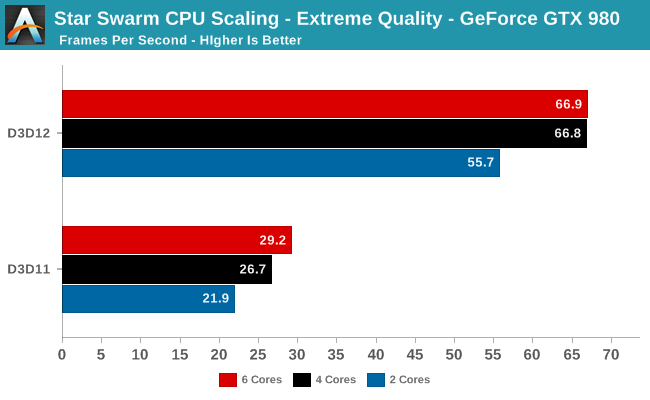
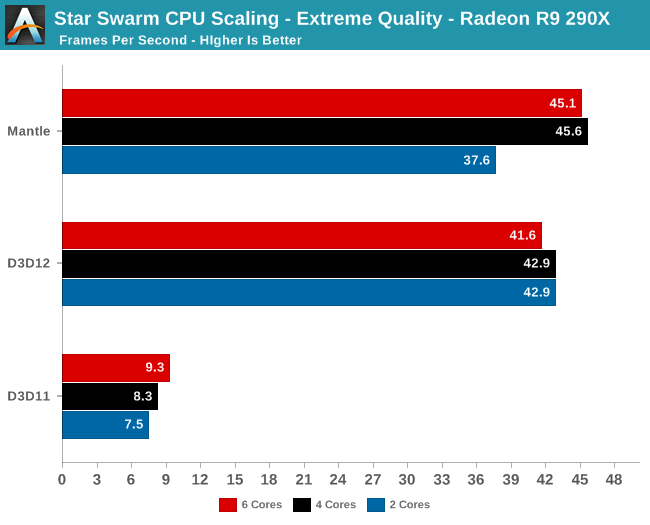
Starting with a look at CPU scaling on our fastest cards, what we find is that besides the absurd performance difference between DirectX 11 and DirectX 12, performance scales roughly as we’d expect among our CPU configurations. Star Swarm's DirectX 11 path, being single-threaded bound, scales very slightly with clockspeed and core count increases. The DirectX 12 path on the other hand scales up moderately well from 2 to 4 cores, but doesn’t scale up beyond that. This is due to the fact that at these settings, even pushing over 100K draw calls, both GPUs are solidly GPU limited. Anything more than 4 cores goes to waste as we’re no longer CPU-bound. Which means that we don’t even need a highly threaded processor to take advantage of DirectX 12’s strengths in this scenario, as even a 4 core processor provides plenty of kick.
Meanwhile this setup also highlights the fact that under DirectX 11, there is a massive difference in performance between AMD and NVIDIA. In both cases we are completely CPU bound, with AMD’s drivers only able to deliver 1/3rd the performance of NVIDIA’s. Given that this is the original Mantle benchmark I’m not sure we should read into the DirectX 11 situation too much since AMD has little incentive to optimize for this game, but there is clearly a massive difference in CPU efficiency under DirectX 11 in this case.
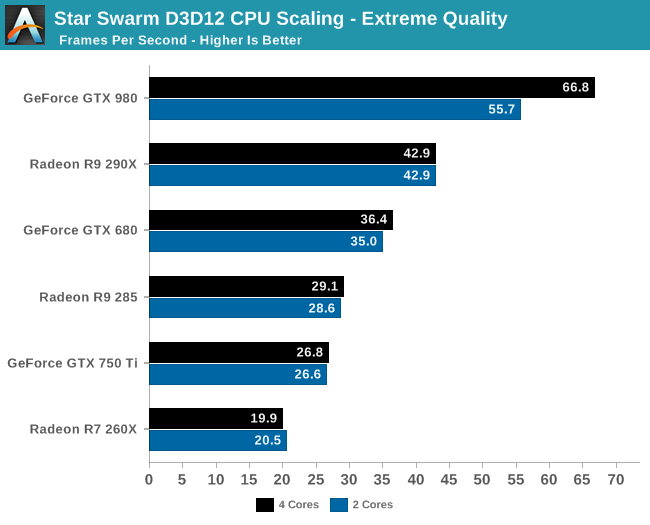
Having effectively ruled out the need for 6 core CPUs for Star Swarm, let’s take a look at a breakdown across all of our cards for performance with 2 and 4 cores. What we find is that Star Swarm and DirectX 12 are so efficient that only our most powerful card, the GTX 980, finds itself CPU-bound with just 2 cores. For the AMD cards and other NVIDIA cards we can get GPU bound with the equivalent of an Intel Core i3 processor, showcasing just how effective DirectX 12’s improved batch submission process can be. In fact it’s so efficient that Oxide is running both batch submission and a complete AI simulation over just 2 cores.
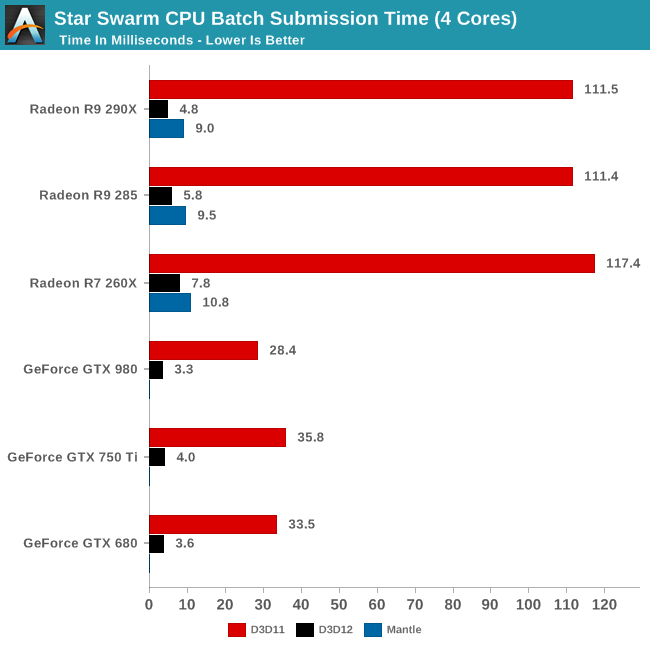
Speaking of batch submission, if we look at Star Swarm’s statistics we can find out just what’s going on with batch submission. The results are nothing short of incredible, particularly in the case of AMD. Batch submission time is down from dozens of milliseconds or more to just 3-5ms for our fastest cards, an improvement just overof a whole order of magnitude. For all practical purposes the need to spend CPU time to submit batches has been eliminated entirely, with upwards of 120K draw calls being submitted in a handful of milliseconds. It is this optimization that is at the core of Star Swarm’s DirectX 12 performance improvements, and going forward it could potentially benefit many other games as well.
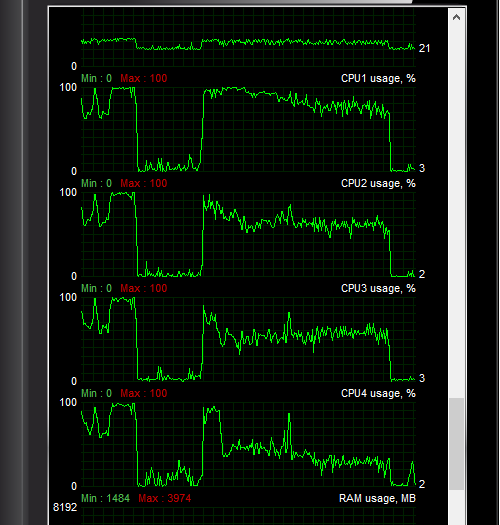
Another metric we can look at is actual CPU usage as reported by the OS, as shown above. In this case CPU usage more or less perfectly matches our earlier expectations: with DirectX 11 both the GTX 980 and R9 290X show very uneven usage with 1-2 cores doing the bulk of the work, whereas with DirectX 12 CPU usage is spread out evenly over all 4 CPU cores.
At the risk of speaking to the point that it’s redundant, what we’re seeing here is exactly why Mantle, DirectX 12, OpenGL Next, and other low-level APIs have been created. With single-threaded performance struggling to increase while GPUs continue to improve by leaps and bounds with each generation, something must be done to allow games to better spread out their rendering & submission workloads over multiple cores. The solution to that problem is to eliminate the abstraction and let the developers do it themselves through APIs like DirectX 12.










245 Comments
View All Comments
Stuka87 - Friday, February 6, 2015 - link
Very promising from the looks of it. Should help out a lot with some of these newer games.One thing I wish you would have done was to show kernel times on the CPU graphs. Would be nice to know how much of that CPU was userspace, and how much was kernel.
unacomn - Friday, February 6, 2015 - link
Very promising results for future games.I would love to see a test with AMD CPUs as well, curious if the architecture of the current AM3+ and FM2 CPUs benefits much in terms of performance from this.
Stuka87 - Friday, February 6, 2015 - link
For Mantle they benefit more, as they are a larger bottleneck. With my old AMD system (965BE @4GHz with an HD7950) BF4 was unplayable with DirectX11, but with Mantle it ran pretty decent.mikato - Friday, February 6, 2015 - link
It seems really strange to read that you couldn't run BF4 with those specs. I play the newest Call of Duty games with my 965BE (not overclocked) and my HD6950 unlocked to 6970. Settings are turned down a bit with my 1920x1200 resolution, but it runs well enough to play as twitchy fast as I need to be. I am in the market for an upgrade soon though so I can turn the settings back up.shing3232 - Friday, February 6, 2015 - link
BF4 are way more demanding than COD because there are too much object in MP especially when you playing a 64 player server.XFR - Friday, February 6, 2015 - link
Are these articles edited or proofread?JarredWalton - Friday, February 6, 2015 - link
Sometimes. I did make a reading/editing pass after this was posted, so if there are still errors let us know.Jtaylor1986 - Friday, February 6, 2015 - link
My only question is how is Mantle still in beta at this stage of the game? Microsoft seems to have developed DirectX 12 much more quickly than AMD has developed Mantlejeffkibuule - Friday, February 6, 2015 - link
It's more likely they were unknowingly developed side-by-side, but DirectX 12 was unveiled much later. Certainly if there were new DX12-only features that require special hardware, some AMD engineers would have wondered why Microsoft was requesting XYZ when developing the Xbox One SoC vs. PS4 (not that those two groups or general engineering teams would have been able to compare notes).Khato - Friday, February 6, 2015 - link
FYI - public announcement comes a long, long time after the initial specification. More importantly, directx is more of a collaboration between the players involved (Microsoft, Intel, NVIDIA, AMD) any more, not something that Microsoft develops in secret and only shares once it's finalized. Which is to say that AMD has known about the direction for directx 12 for over 2 years now.